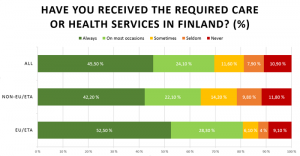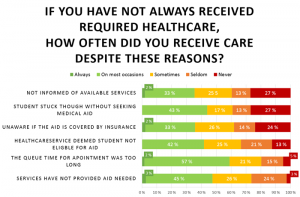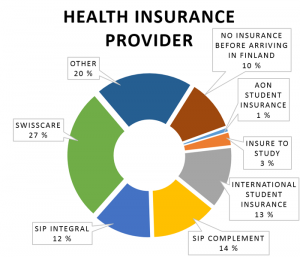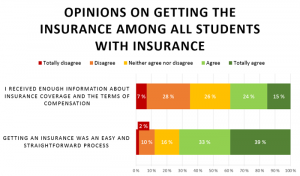Students from outside of the EU/EEA need to have a residency permit to start their studies in Finland, and having a private health insurance is one of the requirements for getting a residency permit. Degree students of all nationalities are entitled to a home municipality in Finland and can use public healthcare services. Students from EU member countries can use public health care services with a European Health Insurance Card. All university students who are members of any student union can also use the Finnish Student Health Service (FSHS/YTHS). However, international students do not have access to KELA benefits (unless they work in Finland for a certain time period).
Aalto University Student Union (AYY) in cooperation with the Student Union of the University of Helsinki (HYY) has conducted a survey on the use of these healthcare services and health insurances among international students in Finland. The survey was produced by the research foundation Otus. The anonymous survey collected 475 answers from students in Aalto and Helsinki universities, 246 of which were degree or exchange students from Aalto University.
In the survey we wanted to find out how well international students know the health service providers, how do the health insurances work and what kind of channels are used to get information on these issues. In the next sections we will first go over receiving care, then health insurances and issues with these.
Receiving treatment
In this section we will present results on how well international students received treatment. One of the questions was how well international students received required health care services while staying in Finland. These results are covered in table 1.
Table 1. Have you received the required care or health services in Finland? (n= 303)
There is a clear difference between students who have come from EU/EAA countries and students from outside EU/EEA in attainment of health care services. Only 64% of non-EU/EEA students said they felt they got the required treatment always or on most occasions, whereas 81% of EU/EEA students report the same.
Out of the students from both EU/ETA and other countries those who did not always receive the care they needed brought up different reasons. These results are represented in table 2.
Table 2. If you have not always received required healthcare, how often did you receive care despite these reasons? (n= 475) (NB. there was an option to choose several reasons)
The main reason for not getting treatment among participants was not knowing what their insurance covered. 64% of the respondents felt that unawareness of these issues lead to them receiving required treatment sometimes, seldom, or never at all. The other major reasons were not being aware of available services and being deemed not eligible for aid by health care services.
Health insurances used by international students
In this section we will go over different health insurances used by international students and their experiences with applying for compensation and dealing with insurance companies. These questions were asked only from students from outside EU/ETA for whom the insurance is required.
There are several health insurance providers international students use. The insurance recommended by Finnish authorities and universities is SIP Insurances, according to a tendering process done in the early 2010s by a consortium of universities. SIP Insurances have a market share of 26% among the respondents. As seen in table 3, other popular insurances are Swisscare (27%) and International Student Insurance (13%).
Table 3. Health insurance provider (n=323)
The respondents were also asked about the process of acquiring an insurance. Only 38% of the respondents felt they had received enough information regarding the contents of the insurance and the terms of compensation, as seen in table 4. Buying an insurance does not seem to be a difficult process for the respondents, but it seems that students just get the insurance for the sake of getting the residency permit – without really knowing how the insurance functions or what its coverage is.
Table 4. Opinions on getting the insurance among students with insurance (n= 323)
As seen in table 5, the biggest problem of getting insurance was not knowing what kind of insurance one should buy, which 35% of respondents found to be an issue. 30% felt it was difficult to find information on the different available options. According to the official report the most popular source of information were university pages (32%), Migri web pages (22%), friends (21%) and Study in Finland web pages (19%).
Some students (4%) found that their general health, such as pre-existing conditions made it hard to get an insurance. This is extremely worrisome and against the principle of equality.
Table 5. Issues when getting the insurance (n=323)
Table 6. shows the issues stated above as complied into different insurance providers. Note that in some of these the amount of answers was very low.
‘Table 6. Insurances as complied by different providers.
Conclusion
International students are required to have a private health insurance in order to commence their studies in Finland, but they are left alone with the problems they face with insurances. There is not enough information provided by the authorities, Study in Finland page or the universities, and when compared to similar pages in other European countries, the level of detail on Finnish pages is rather low.
Finnish authorities and universities only thinking about providing international students with degrees is unsustainable. A more holistic approach to internationalisation of universities is needed in Finland. Putting efforts into developing degrees and teaching is important, but if basic services like health care, banking or immigration services have grave problems, Finland is hardly a dream destination. What needs to be taken into account is the whole experience of integrating international students into the Finnish society, and problems with basic needs such as healthcare reflect negatively on the image of Finnish education.
International students have the right to a well-functioning, affordable and accessible insurance, as well as proper information on healthcare and health insurances. Issues with health care and adequate compensation for health care costs need to be taken very seriously. If Finland truly wants to welcome its international students, all parties involved need to step up their game. A new tendering process is needed, as the health insurance now recommended by the universities and authorities has the gravest problems and lowest customer satisfaction among students. Immigration authorities, universities and the National Agency for Education need to sit down together and start developing solutions.
Milla Ovaska, Specialist, International Affairs
Aalto University Student Union
contact: international(at)ayy.fi





